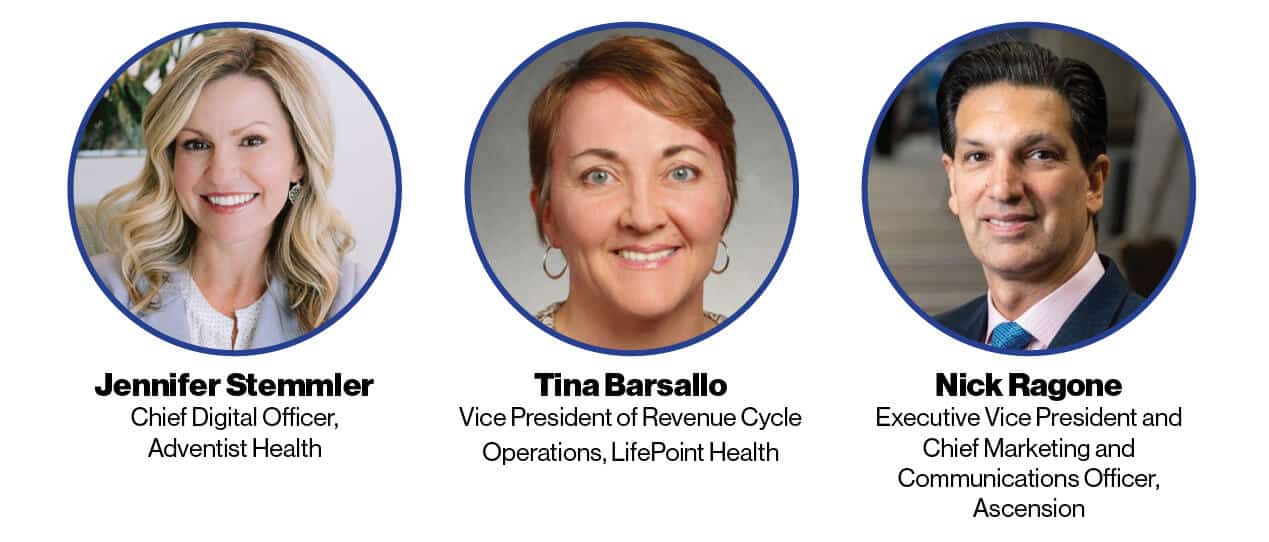Since the start of the pandemic, countless healthcare financial leaders from around the country have spent sleepless nights contemplating their biggest concerns: rising operating costs, optimizing the use of new technology, navigating the labor market and improving the patient experience. After several years of this, many hospitals and health systems are looking for a new way forward.
Kaufmann Hall’s March 2023 National Hospital Flash Report shows hospital finances are beginning to stabilize. Whether this is good news or not is debatable as the data indicates low margins have become the new normal.
R1 RCM asked three of their revenue cycle partners from different health systems how revenue cycle outsourcing has benefitted their organization’s bottom line and the patient experience.
Jennifer Stemmler, Chief Digital Officer, Adventist Health
Background: Adventist Health, a California-based health system, serves more than 80 communities along the West Coast and Hawaii.
The challenge: Adventist needed to adopt consumer-facing technology to give patients what they wanted: healthcare technology products and pricing transparency. “73% of our complaints were around the bill. We could do a knockout job with care transformation and care redesign and have this great clinical experience and then just kill it on the bill,” says Stemmler.
Adventist also had a goal of doubling the number of lives served by 2030. Knowing they couldn’t double the number of clinicians, support staff, revenue cycle associates and more, they needed to think outside the box. “The only way we can do that is to have digital be the first way we touch a patient, which also frees up time to let physicians and other staff focus on providing a white glove experience to their patients,” said Stemmler. She adds that the use of personalized technology engages patients in a way they are familiar and comfortable with.
Stemmler says bringing in consumer-facing technology can help improve the patient experience, and that the push towards becoming patient-centric boils down to transforming a health system’s business model.
How R1 helped: Adventist Health partnered with R1 to implement consumer-facing onboarding and intake solutions. These technology-based consumer tools give patients the resources that allow them to manage some of the administrative parts of healthcare, including uploading their medical history, medications, insurance and billing information, and more.
R1 also worked with Adventist to simplify and personalize the patient financial experience utilizing Patient Resolution, an R1 solution. She says this technology gives patients payment options and an improved user experience.
“We’re incredibly excited to partner with R1 because in my mind they really do book-end the experience,” said Stemmler.
Key takeaway: Find an RCM outsourcing partner with a strong history of digital strategy expertise who can transform the patient experience.
New data-packed report now available
If you’re looking for key trends, data insights and clear-cut opportunities for cutting costs, increasing revenue and improving the patient experience, download our exclusive report now.
Tina Barsallo, Vice President of Revenue Cycle Operations, LifePoint Health
Background: LifePoint Health operates more than 65 hospitals, as well as more than 30 behavioral health and rehab hospitals, across almost 30 states.
The challenge: LifePoint needed to build out a revenue cycle for 26 acquired hospitals that utilized seven different EHR systems. To do this, they built a 200-plus employee central business office (CBO) to support the back end of the revenue cycle process for those hospitals. “We really thought we could do it ourselves and not partner for these facilities,” said Barsallo. Despite the new CBO, they realized the need for additional support and started seeking revenue cycle partnerships. They placed an equally strong focus on finding both the right cultural and technological fit.
“We wanted our partner to have the people, processes and technologies we were looking for and to leverage the existing talent we had built within our CBO,” said Barsallo. They also needed a partner who had the processes and technology that could sit on top of seven different EHR systems and potentially expand to their full group of 65 facilities in the future. “We wanted a partner that had end-to-end technologies and a robust patient experience strategy.”
How R1 helped: After a substantial search, LifePoint partnered with R1. This partnership has allowed LifePoint Health to centralize and standardize processes and improve user experiences.
“Partnering with R1, especially on the front end, allows us to centralize scheduling with the EMRs that we work with,” said Barsallo. “Having technology like R1 Patient Resolution placed on top of that is allowing us to centralize the scheduling process.”
Key takeaway: Balance culture and technology to build standardization.
Nick Ragone, Executive Vice President and Chief Marketing and Communications Officer, Ascension
Background: Ascension operates 143 hospitals and more than 40 senior living facilities in 19 states and the District of Columbia.
The challenge: With hospitals across the country, Ascension needed a consistent brand experience that consumers could navigate, including a seamless and integrated billing and revenue cycle that could sit on top of multiple EHRs.
The organization measures 50 touchpoints that form the patient experience, and Ragone notes that only a small percentage include the clinical touch and health outcomes. “The number one dissatisfier is around payment and insurance … and it’s disproportionate to everything else. But I honestly believe that the answer to these problems is to figure out how to be partners with our payers,” said Ragone.
How R1 helped: Ascension and R1 have also worked together to navigate changing patient expectations in an industry where the payer is the middleman between the consumer and the product. R1 operates on top of multiple EHRs to provide integrated seamless services including online scheduling, mobile check-in and online payments to provide clarity for patients about insurance and out-of-pocket responsibility.
A large part of R1’s partnership with Ascension is built on R1 being able to represent the Ascension brand. “The consumer doesn’t differentiate between Ascension and R1,” said Ragone. “We work closely to make sure they know how to live out our brand values.”
Key takeaway: Navigate payer and revenue cycle relationships to build a consistent consumer journey. There is mounting pressure on healthcare systems to viably operate with razor-thin margins. Adding to this pressure is an unprecedented labor shortage and patients who expect more than ever before. Revenue cycle outsourcing can help alleviate some of the labor stress and lead to higher operating margins.
Want more information about how to choose an RCM outsourcing partner? Download the research brief, Vetting the Right Revenue Cycle Partner, published by The Health Management Academy.






